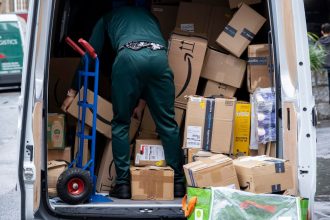Unlock the Editor’s Digest for free
Roula Khalaf, Editor of the FT, selects her favourite stories in this weekly newsletter.
Europe’s first new heavy-lift rocket in almost 30 years soared into space on Tuesday, promising an end to a crisis over the region’s ability to deploy its own satellites into orbit.
Ariane 6, four years late and heavily subsidised to ensure it can compete against Elon Musk’s SpaceX, lifted off under clear skies from its launch pad near Kourou in French Guiana at about 4pm local time.
The mission was judged a success by the European Space Agency, which oversees the Ariane programme, despite the rocket encountering a problem with its auxiliary power unit (APU), which failed to switch on in the final phase of the flight.
That meant the rocket’s upper stage could not be brought back to earth in a controlled re-entry as planned. It will instead continue to orbit the Earth for potentially several years. Eventually, it will be pulled into the Earth’s atmosphere, where it will partially burn up.
Josef Aschbacher, director-general of the ESA, was jubilant after Ariane 6 released its satellite payloads into orbit roughly one hour into the three-hour mission.
“We are making history now,” said Aschbacher. “There is still a bit of work to do but . . . this is such a beautiful moment.” Later, after the end of the mission, he insisted the inaugural flight had put Ariane 6 on track to ramp up the number of launches next year. The rocket is expected to fly at least nine times a year by 2026.
“This powers Europe back into space,” Aschbacher said.
Technicians and engineers in the Guiana Space Centre’s Jupiter control room, many of whom have spent a decade working on the programme, applauded as the rocket flew through a series of milestones.
The most important was demonstrating that the Vinci engines powering the rocket’s upper stage had stopped and restarted to deposit satellites into different orbits roughly 600km above earth.
The launch should restore Europe’s independent access to space, where nations are battling to gain strategic and economic advantage.
But there are questions over how competitive Ariane 6 will be against Musk’s reusable Falcon 9 rocket, or his far bigger Starship, which this year completed a successful test flight into space.
Last year the 13 ESA member states that helped fund Ariane 6 agreed a €1bn subsidy over three years, on top of the programme’s estimated €4bn development cost.
European concerns about sovereign access to space have intensified since the retirement of Ariane 5 last year. The delays to Ariane 6 meant it was unable to take over from its predecessor, while co-operation with Russia’s Soyuz programme collapsed after its full-scale invasion of Ukraine. Italy’s new Vega-C rocket has also been delayed by technical issues.
Europe has been forced to turn to SpaceX to launch four important satellites, including two for the Galileo navigation system, while four more will fly with the US company later this year.
As a result Europe is reviewing the way it collaborates on launcher programmes.
Last year the ESA, which has 22 member states including the UK and Switzerland, launched a competition to buy micro launch services from the private sector. Some of those companies may eventually snare business from Ariane.
German rocket start-up Rocket Factory Augsburg last week described Ariane 6 as “overpriced”, saying its development “at the taxpayer’s expense has shown that something has to change”.
But even RFA welcomed Ariane 6’s flight as a significant moment for Europe.
“Europe has finally regained autonomous access to space and can once again play an active role in shaping global space travel,” said co-founder Jörn Spurmann.
Ariane is expected to make its first operational flight by the end of the year. It is already booked for 29 launches, of which 18 will be for Amazon’s Project Kuiper broadband satellite constellation from next year.
The Ariane 6 programme has been criticised because the rocket will not be reusable, unlike Falcon 9.
However, manufacturer ArianeGroup, and launch service provider Arianespace, are hoping that the rocket’s flexibility will give it an advantage over SpaceX.
Read the full article here




